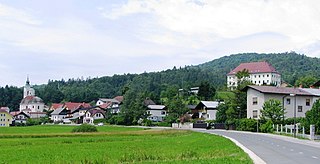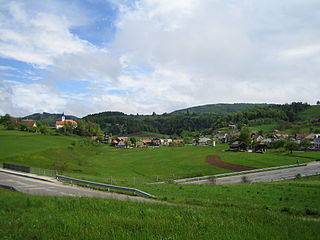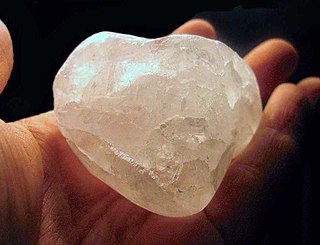
Hrastnik is a town in the Central Sava Valley in central Slovenia. It is the seat of the Municipality of Hrastnik. Traditionally the area was part of the Styria region. The entire municipality is now included in the Central Sava Statistical Region. The town has its own library and school.

Borovnica is a settlement in the Municipality of Borovnica in the Inner Carniola region of Slovenia. It is about 20 kilometres (12 mi) southwest of the national capital Ljubljana.

Gorenja Vas is a settlement in the Poljane Sora Valley and the administrative centre of the Municipality of Gorenja Vas–Poljane in the Upper Carniola region of Slovenia. In addition to the settlement core of Gorenja Vas itself, the settlement also consists of the hamlets of Sestranska Vas north of the Poljane Sora River, and Trata and Lajše south of the settlement core.

Jazbine is a dispersed settlement in the Municipality of Gorenja Vas–Poljane in the Upper Carniola region of Slovenia.

Dobrova is a clustered settlement northwest of Ljubljana in the Upper Carniola region of Slovenia. It is the administrative centre of the Municipality of Dobrova–Polhov Gradec. It lies on the road from Ljubljana to Polhov Gradec at the point where roads split off to Horjul to the southwest and to Šentvid, Ljubljana to the northeast. It extends along the flat area to the northeast up to the Gradaščica River and encompasses much of Dobrova Hill to the southwest. Bezenica Creek, Broad Creek, and Ječnik Creek, left tributaries of the Horjulščica River, flow through the hills west of the settlement. Dobrova includes the hamlets of Pod Kotom northwest of the main settlement and Graben southwest of the main settlement.

Šentjošt nad Horjulom is a settlement in the Municipality of Dobrova–Polhov Gradec in the Upper Carniola region of Slovenia. In addition to the main settlement, it also includes the hamlets of Kogel, Krvinet, Kurja Vas, Paradiže, Pišek, Potok, and Stavnik, as well as part of the hamlet of Suhi Dol.

Križevska Vas is a small settlement in the Municipality of Dol pri Ljubljani in the eastern Upper Carniola region of Slovenia.

Povir is a village in the Municipality of Sežana in the Littoral region of Slovenia. It includes the hamlets of Britof, Dulanja Vas, and Guranja Vas.

Otlica is a dispersed settlement in the hills north of Ajdovščina in the Littoral region of Slovenia. It is made up of smaller clusters of the hamlets of Sibirija, Kitajska, Kurja Vas, and Cerkovna, as well as a number of outlying isolated farms. Together with the ridge-top villages of Predmeja, Kovk, and Gozd, it is part of an area locally known as Gora.

Bojanja Vas is a village in the Municipality of Metlika in the White Carniola area of southeastern Slovenia, next to the border with Croatia. The entire area is part of the traditional region of Lower Carniola and is now included in the Southeast Slovenia Statistical Region.

Zajčje Polje is a settlement in the Municipality of Kočevje in southern Slovenia. It was inhabited mostly by Gottschee Germans. The area is part of the traditional region of Lower Carniola and is now included in the Southeast Slovenia Statistical Region.

Stari Kot is a village in the Municipality of Loški Potok in southern Slovenia, next to the border with Croatia. The area is part of the traditional region of Lower Carniola and is now included in the Southeast Slovenia Statistical Region. It consists of the hamlets of Binkl, Kurja Vas, Pri Ambrožiču, Hrib, and Preska. The main road from Lazec to Prezid runs through the village.

Janče is a dispersed settlement in the hills south of the Sava River east of the capital Ljubljana in central Slovenia. It belongs to the City Municipality of Ljubljana. It was part of the traditional region of Lower Carniola and is now included with the rest of the municipality in the Central Slovenia Statistical Region.

Sadinja Vas is a settlement in the City Municipality of Ljubljana in central Slovenia. It is part of the traditional region of Lower Carniola and is now included with the rest of the municipality in the Central Slovenia Statistical Region.

Kolovrat is a settlement in the Municipality of Zagorje ob Savi in central Slovenia. The area is part of the traditional region of Upper Carniola. It is now included with the rest of the municipality in the Central Sava Statistical Region. The settlement includes the hamlets of Kal, Plavišnik, Prevalje, Spodnje Vrtače, Senčna Vas, and Strma Njiva.

Zabukovica is a settlement in the Municipality of Žalec in east-central Slovenia. It lies in the hills south of Žalec. The area is part of the traditional region of Styria. The Municipality of Žalec is included in the Savinja Statistical Region. Zabukovica includes the hamlets of Kurja Vas, Močle, Odele, Podvine, Porence, Slovenski Dol, Sončni Hrib, and Zabukovška Vas.

Nestoplja Vas is a small village in the Municipality of Semič in Slovenia. The area is part of the historical region of Lower Carniola. The municipality is now included in the Southeast Slovenia Statistical Region.

Polica is a settlement in the Municipality of Grosuplje in central Slovenia. The area is part of the historical region of Lower Carniola. The municipality is now included in the Central Slovenia Statistical Region. Polica includes the hamlets of Bliska Vas, Žabja Vas, Hrib, and Goričane.

Gabrje pri Stični is a settlement just north of Stična in the Municipality of Ivančna Gorica in central Slovenia. The area is part of the historical region of Lower Carniola. The municipality is now included in the Central Slovenia Statistical Region. The settlement includes the hamlets of Kurja Vas, Potok, Pungrt, and Nograd.

Grče is a village in the Municipality of Žalec in east-central Slovenia. It lies on the southwest part of the Ponikva Plateau. The area is part of the traditional region of Styria. The municipality is now included in the Savinja Statistical Region.























